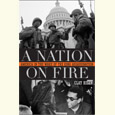MaDear’s Scrapbook
A granddaughter discovers an unexpected legacy of memories, questions, and untold stories
For years, I thought I was the sole oddball in my family possessed by the compulsion to cut, paste, and save all manner of memorabilia. If not for an impromptu visit to my Aunt Doris’s house, I might never have known otherwise.
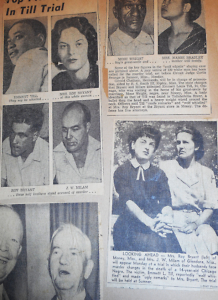 On my arrival that day, I found my aunt sorting through some of her deceased mother’s personal items. Our “MaDear”—Ethel V. Johnson, my grandmother—died in Memphis, Tennessee, in August of 1999, and I’m guessing this particular visit to my aunt’s home took place shortly thereafter. In any case, when Aunt Doris asked if I wanted the large, tattered brown album that had once belonged to MaDear but was now destined for the garbage pile, I was quick to say, “Yes!” without even knowing what the album contained.
On my arrival that day, I found my aunt sorting through some of her deceased mother’s personal items. Our “MaDear”—Ethel V. Johnson, my grandmother—died in Memphis, Tennessee, in August of 1999, and I’m guessing this particular visit to my aunt’s home took place shortly thereafter. In any case, when Aunt Doris asked if I wanted the large, tattered brown album that had once belonged to MaDear but was now destined for the garbage pile, I was quick to say, “Yes!” without even knowing what the album contained.
On cautiously peering inside the fragile relic, I was thrilled to discover that the pages, though faded and crumbling, were filled with an assortment of items, including newspaper articles, greeting cards, recipes, death notices, funeral programs, and wedding keepsakes. I would never have guessed that my MaDear, of all people, had been interested in collecting and preserving such odds and ends. But judging from the earliest of the decipherable dates in the oversized album, scrapbooking held my grandmother’s attention and interest for nearly thirty years.
Born black and female in the rural South of 1912, Ethel V. Hunter married her childhood sweetheart, Bill Larther Johnson, when she was just eighteen. Their union lasted nearly sixty years and was blessed with five children. For most of her life, MaDear lived in “Johnson Subdivision,” a rural enclave in southwest Memphis that’s located less than a ten-minute drive from Elvis Presley’s Graceland. Marked by dirt and gravel roads, overgrown brush, foul-smelling ditches, and simple wood-frame homes, for more years than not “Johnson Sub” seemed perpetually trapped in a bygone era, especially given the paved, well-lit streets, manicured lawns, and stately brick homes of so many other neighborhoods bordering Graceland.
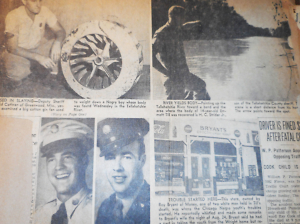 From what I gather, my grandmother was a bit of a hellion in her youth—brash, opinionated, and incredibly headstrong. But the grandmother I knew—a plump, bespectacled woman with thin graying hair that just barely held a curl—wasn’t one to raise her voice, except when she was cutting loose with the choir at Old Nonconnah Missionary Baptist Church, or fussing at my poor granddaddy, or keeling over with laughter, which she did on a fairly regular basis.
From what I gather, my grandmother was a bit of a hellion in her youth—brash, opinionated, and incredibly headstrong. But the grandmother I knew—a plump, bespectacled woman with thin graying hair that just barely held a curl—wasn’t one to raise her voice, except when she was cutting loose with the choir at Old Nonconnah Missionary Baptist Church, or fussing at my poor granddaddy, or keeling over with laughter, which she did on a fairly regular basis.
My grandmother’s keen sense of humor and eye for the absurd spilled over in nearly every tale she told. Like a harmless Pied Piper, she owned the ability to hold an audience captive with both her words and the musical ebb and flow of her voice. No doubt my MaDear’s lap is where I first fell in love with the art of storytelling, where I first heard words like chill’un and chill’ren, the place where I first reveled in the delectable thrill and wonder of Southern black expressions like “Chile, sho’nuff?” and “Girl, what you say?”
Given my grandmother’s love of the lighthearted, I would have expected her scrapbook to lean in that direction. But only the barest hint of MaDear’s wit is evident amid the hodgepodge of saved items. Most of the album’s contents are of a straightforward and serious nature and, oddly enough, primarily consist of clippings from two Memphis newspapers—The Commercial Appeal and the Memphis Press-Scimitar. These newspaper articles, at least the ones that are still relatively legible and intact, suggest that my grandmother either started the scrapbook in the mid-1950s or else began cutting and saving articles from that period only to paste them into the album at some later date.
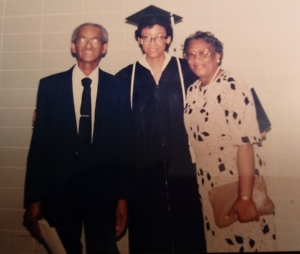 One event in particular from 1955 that clearly seized MaDear’s interest was the slaying of fourteen-year-old Emmett Till. While visiting relatives in Money, Mississippi, for the summer, Till, a Chicago native, was kidnapped and murdered for allegedly whistling at a white woman. The white men who murdered the child were summarily tried and found not guilty, though they later admitted to the crime. MaDear’s album includes a number of detailed newspaper articles and photographs about the lynching, the trial, and the individuals involved. Given the number of articles about the incident and the fact that I’ve been unable to identify anything in the album dated prior to 1955, I can’t help but wonder if Till’s murder is what originally sparked my grandmother’s interest in assembling a scrapbook.
One event in particular from 1955 that clearly seized MaDear’s interest was the slaying of fourteen-year-old Emmett Till. While visiting relatives in Money, Mississippi, for the summer, Till, a Chicago native, was kidnapped and murdered for allegedly whistling at a white woman. The white men who murdered the child were summarily tried and found not guilty, though they later admitted to the crime. MaDear’s album includes a number of detailed newspaper articles and photographs about the lynching, the trial, and the individuals involved. Given the number of articles about the incident and the fact that I’ve been unable to identify anything in the album dated prior to 1955, I can’t help but wonder if Till’s murder is what originally sparked my grandmother’s interest in assembling a scrapbook.
For me, the collection of articles on the murder are all the more significant because MaDear’s home is where I, as a child, first learned the gruesome details of the tragedy. The year was 1970-something and I was barely a preteen when, while seated in my grandmother’s living room and happily thumbing through a basket of old Jet magazines, I happened upon both the story and the horrific photo of Emmett Till’s bloated and mutilated body, which had been displayed in an open casket at his grief-stricken mother’s request. So grotesque and inhuman was the image to me that I initially couldn’t believe it was real. Surely this was a mannequin of some sort and not an actual child’s body. Though slow to sink in, the truth seared a permanent impression into the dark recesses of my mind. Even now, when I close my eyes, the image is one I can readily conjure. Moreover, I believe my own obsession with black history has its origins in that jarring moment of discovery.
A decade or so before MaDear’s death, I conducted a series of taped interviews with her on our family’s history. Had I known then about her scrapbook, I would have surely asked about its contents. Her collection of articles on the murder of Emmett Till would have ranked high on my list of inquiries. What had driven her to clip and save so many news stories about the incident? Had she noticed that, in their coverage of the event, the Press-Scimitar had consistently written the word “negro” with a lower-case “n” rather than “Negro,” like The Commercial Appeal? Given that she grew up in the South during a time when lynchings weren’t uncommon, had she ever known anyone who’d been a victim of a lynching? Or, dare I ask, had she ever witnessed one? Finally, why hadn’t she clipped and saved articles about any of the other major civil-rights events that occurred between the mid-1950s and mid-1980s?
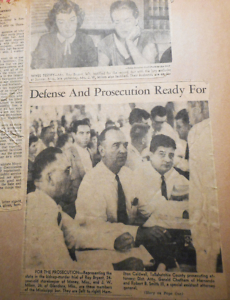 Even though MaDear’s scrapbook includes a number of news clippings about sit-ins, boycotts, segregation policies, and racially motivated acts of violence, most if not all of the news stories are specific to the tri-state area of Tennessee, Mississippi, and Arkansas. Why, given my grandmother’s obvious interest in the struggles of black folks, are there no articles in her album about Rosa Parks and the 1955 Montgomery bus boycott? What about 1957’s Little Rock Nine, or the March on Washington in 1963, or the bombing that same year of the church in Birmingham that led to death of four little girls? Not even Lyndon B. Johnson’s signing of the Voting Rights Act of 1965 warranted a mention. Most perplexing of all is the absence of a single article pertaining to the two most significant local events of my grandmother’s lifetime: the Memphis Sanitation Workers Strike of 1968 and the assassination of Martin Luther King Jr. at the Lorraine Motel.
Even though MaDear’s scrapbook includes a number of news clippings about sit-ins, boycotts, segregation policies, and racially motivated acts of violence, most if not all of the news stories are specific to the tri-state area of Tennessee, Mississippi, and Arkansas. Why, given my grandmother’s obvious interest in the struggles of black folks, are there no articles in her album about Rosa Parks and the 1955 Montgomery bus boycott? What about 1957’s Little Rock Nine, or the March on Washington in 1963, or the bombing that same year of the church in Birmingham that led to death of four little girls? Not even Lyndon B. Johnson’s signing of the Voting Rights Act of 1965 warranted a mention. Most perplexing of all is the absence of a single article pertaining to the two most significant local events of my grandmother’s lifetime: the Memphis Sanitation Workers Strike of 1968 and the assassination of Martin Luther King Jr. at the Lorraine Motel.
I may never uncover the reasons behind MaDear’s decision to include certain items in her scrapbook while omitting others. My guess is that she was simply overwhelmed (emotionally and otherwise) by the sheer number of racially charged and life-altering events occurring during that period. But as puzzled as I am by many of my grandmother’s choices, I am grateful that she at least attempted to preserve some of her memories and interests—a strange yet oddly satisfying compulsion that neither of us knew the other owned.
Having access to an album full of almost three decades’ worth of my grandmother’s memories has compelled me to consider what might perplex some future grand- or great-grandchild of mine on encountering my scrapbook. These days when I’m working on a scrapbooking project, I make more of an effort to provide bits of information and explanations. I identify people and places, and I include personal commentary about the significance of the relics and memories I’ve chosen to preserve on acid-free paper between the covers of a sturdy faux-leather binder.
I thought I knew my grandmother. My exposure to her scrapbook revealed just how much I didn’t know about aspects of her personality and the depth of some of her interests. I will likely forever be haunted by those questions I never even knew to ask. Still, every time I flip through the brittle pages of MaDear’s scrapbook, I feel as though I’ve been bequeathed a precious gift—one lovingly crafted by my grandmother’s hands and ultimately intended just for me.
[This essay originally appeared on August 10, 2018.]
 Copyright (c) 2018 by Lori D. Johnson. All rights reserved. Lori D. Johnson earned an M.A. degree in Urban Anthropology from the University of Memphis. She is the author of two novels, A Natural Woman and After The Dance. Her work has appeared in a variety of publications, including The Root, Mississippi Folklife, Upscale Magazine, Memphis Magazine, The Commercial Appeal, The Tri-State Defender, and Obsidian II: Black Literature in Review. She lives in Charlotte, North Carolina, but still considers Memphis home.
Copyright (c) 2018 by Lori D. Johnson. All rights reserved. Lori D. Johnson earned an M.A. degree in Urban Anthropology from the University of Memphis. She is the author of two novels, A Natural Woman and After The Dance. Her work has appeared in a variety of publications, including The Root, Mississippi Folklife, Upscale Magazine, Memphis Magazine, The Commercial Appeal, The Tri-State Defender, and Obsidian II: Black Literature in Review. She lives in Charlotte, North Carolina, but still considers Memphis home.

